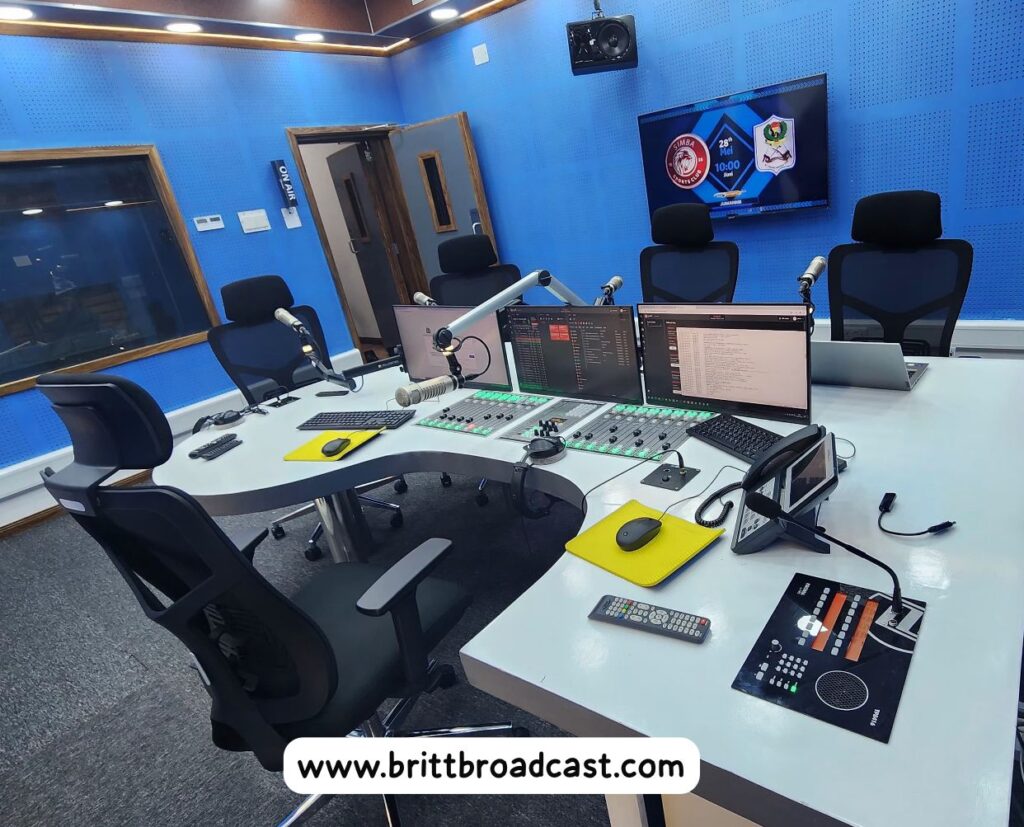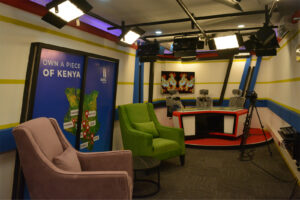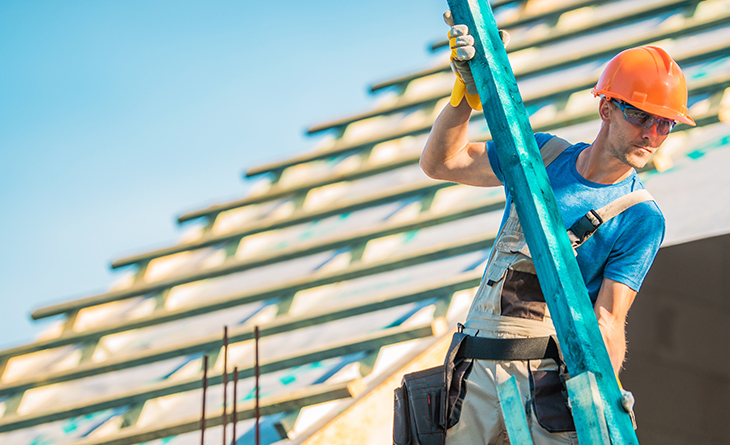Studio Equipment
We focus on providing FM & TV broadcasting equipment solutions that are modern, reliable, and cost-effective delivering world-class entertainment experiences.
Radio Studio Equipment
Easier Than You Think!
Starting a radio station can seem overwhelming, but with Britt Broadcast by your side, it’s easier than you think. Our expert team will guide you through every step of the process—from selecting the right technology to managing daily operations. Whether you’re building a new station or upgrading your existing setup, we offer the support you need for a smooth, successful launch.
Your Preferred Broadcast Method
Choosing the right broadcasting method is key to your radio station’s success. Factors like budget, target audience, and local regulations will influence your decision. Here are the main options:
- Traditional AM/FM: AM/FM broadcasting offers broad reach but requires licenses and physical transmission equipment. It’s ideal for reaching listeners in offices, homes, and vehicles.
- Streaming / Web Radio: A cost-effective option that doesn’t require expensive equipment or licenses, but you’ll still need to acquire music licenses. Streaming offers global access via computers, smartphones, and smart speakers.
- Satellite / DAB Digital: Satellite broadcasting offers extensive geographical coverage but requires specialized equipment and can be a costly solution.
Key Equipment for Your Radio Studio
To build your ideal radio studio, the following equipment is essential:
- Studio Microphones: High-quality microphones designed to capture a wide range of sounds.
- Audio Mixer Console: The control center of your studio for recording, mixing, and optimizing your audio.
- Headphones: Vital for monitoring on-air sound and ensuring optimal audio quality.
- Mic Arms: Adjustable arms for positioning your microphones comfortably.
- Headphone Distribution & Amplifiers: To allow multiple users to monitor audio with independent volume controls.
- Monitor Speakers: High-quality speakers for sound monitoring without headphones.
- Telephone System: Essential for managing live phone calls during broadcasts.
- On-Air Light: A light that signals when the microphone is active.
- Automation & Playout Software: Software to automate background music, commercials, and radio programming.
- RDS Encoder: Used to transmit essential station information, like song data and station name, to compatible receivers.
- Audio Processor: Optimizes your station’s sound quality.
- FM Tuner: Allows you to monitor and compare your broadcast’s audio quality.
TV Studio Equipment
We specialize in providing comprehensive solutions for TV studios, ensuring that all your equipment and software needs are met for smooth, professional broadcast operations. Whether you’re setting up a new station or upgrading an existing facility, we offer cutting-edge TV automation software, broadcast equipment, and expert advice to help streamline your production process.
- TV Automation Software :TV automation software is vital for scheduling and controlling a station’s video stream.
- Playout software manages the entire broadcast schedule, automating it based on preset rules or manually scheduling content. It also manages commercials, and generates reports for regulatory compliance.
- Router: The video router is the hub for managing video signals. With multiple inputs and outputs, it sends SDI signals and can be controlled remotely to manage real-time broadcasts.
- Cameras: Cameras, ranging from handheld to studio-grade, are essential for video production, capturing everything from live events to studio programming.
- Audio Equipment: Microphones amplify voices, while the

- Mixing console manages audio levels from various sources, ensuring optimal sound quality.
- Video Mixer/Switcher: The video mixer switches between video feeds, adds effects, and combines multiple video sources into a seamless broadcast.
- Studio Prompter/Teleprompter: Teleprompters allow hosts to read scripts while keeping eye contact with the camera, ensuring smooth live delivery.
- Audio and Video Monitoring: Monitors ensure the quality of both audio and video signals, helping operators detect and resolve issues in real-time.
- Converters: Converters, like SDI to HDMI, ensure compatibility across different video formats and equipment.
- Clock : Studio clocks are essential for maintaining accurate timing and keeping the production on schedule.
- TV Lighting Equipment: Lighting provides the right visibility for the camera and helps set the tone and atmosphere of the broadcast.
- Studio Intercom System: The intercom system enables clear communication among the production crew across different studio spaces.
- Tripods: Tripods provide stable support for cameras, essential for steady, high-quality shots during filming.
Easier Than You Think!
Starting a radio station from scratch can be a daunting task, but it doesn’t have to be. Our team can provide you with the guidance and support you need to get your station up and running smoothly. From planning and selecting the right technology platforms to practical operation and management, we’re here to help you every step of the way.
Your preferred broadcast method
When deciding on your radio station’s broadcasting method, it’s important to consider factors such as your budget, target audience, and local regulations. This will help determine which of the various potential options is most suitable for you.
- Traditional AM/FM
In many areas, broadcasting on AM/FM radio is subject to regulation and requires obtaining broadcast licenses as well as music copyright licenses. In addition, physical transmission equipment and access to a suitable transmission site are necessary. The difficulties of launching a traditional radio station vary by region. However, traditional “over the air” broadcasting on AM/FM provides extensive availability for your service, as it can be accessed in offices, homes, and vehicles. - Streaming / Web
Our company provides a comprehensive web radio broadcasting platform solutions that can aid you in launching your service with ease. Utilizing this platforms can be a cost-effective solution for many stations, as it does not require expensive broadcasting equipment or licenses. However, acquiring appropriate music licenses for your web radio station is still necessary.
Streaming your radio station on the web also presents the opportunity for widespread accessibility to your listeners. They can access your station through various devices such as computers, mobile phones, and smart speakers.
- Satellite / DAB Digital
In certain regions, satellite broadcasting might be the only option to achieve broad geographical coverage, but this can be a costly solution that demands specialized equipment for both transmission and reception.
List of equipment
1. Studio Microphones
Our top-quality microphones are tailored to meet the specific needs of our clients. These devices are essential for capturing and recording a wide range of audio, including voices, music, and sound effects. They work by converting sound waves into electrical impulses.
2. Audio Mixer Console
The audio console, also known as a sound desk, radio panel, or sound panel, serves as the control interface for your radio station. It is responsible for recording, equalizing, and optimizing your program, ensuring that it sounds just right on air.
3. Headphones
When a microphone channel is activated, the studio monitor speakers are automatically silenced. To monitor the on-air sound, individuals in the studio must use headphones. Selecting the right headphones can be a subjective process, influenced by factors such as personal comfort and desired frequency response.
4. Mic Arms
Mic arms are designed to hold studio microphones and allow users to adjust the height level and position of the microphone to their preference. Depending on the client’s studio, we offer a variety of mic arms to choose from.
5. Headphone Distribution and Amplifier
In broadcasting, it is often necessary to connect multiple users to a single audio source. This is particularly true for shows that involve multiple participants. To accommodate this, each output features an independent volume adjuster, allowing users to set their preferred volume level.
Headphone amplifiers, or “headphone amps,” are a crucial tool for on-air talents. By isolating the audio feed from external sounds and distractions, they help to maintain the flow of the program and allow users to hear themselves and others clearly. This ensures that everyone involved in the broadcast can hear exactly what the listeners are hearing on their radios.
6. Monitor Speakers
For a radio studio, having high-quality monitor speakers is crucial. They enable audio monitoring without the requirement for headphones, providing a convenient way to identify any potential problems with sound quality.
7. Telephone system
In a broadcasting setup, a Telephone Hybrid Interface is necessary to connect the console with audio signals from phone calls. This is particularly important for on-air talent who need to take phone calls during a broadcast.
8. On Air Light
When a microphone channel is turned on, the audio console automatically switches the corresponding light on/off to notify that the show is live or not.
9. Automation and Playout Software
The Automation Software is a computer system designed to provide continuous background music and commercials during a radio broadcast. It simplifies the operation of a one-person production crew, allowing them to produce, record, and even edit a radio program independently.
The Play Out System, also known as Automation Software, is a specialized computer program that facilitates the seamless playback of audio with detailed control for performers. The Automation System also serves as the storage database for all audio files and commands that need to be played at specific times.
10. RDS Encoder
Radio Data System (RDS) is a method of transmitting ASCII text and other metadata to compatible radio receivers. It enables stations to encode essential information such as the station name, song data, program guide, and traffic updates.
Some FM audio processors have built-in RDS encoders, while others require external encoders. If you are using an external RDS encoder, it should be connected to the SCA input on your stereo generator or processor.
11. Audio Processor
This crucial piece of equipment optimizes and enhances the sound quality of your radio broadcast, giving it a distinctive character and a unique sound. It’s usually the final piece of equipment used before audio is transmitted, making it essential to achieving high-quality audio output.
12. FM Tuner
Monitoring the quality of your audio broadcast is essential to ensure that the sound you’re transmitting is of good quality. By doing so, you can also make comparisons with the audio output of your competitors, giving you a competitive edge.
- TV Automation Software
This is essential for managing the scheduling and video stream of a television station. This software, which interfaces with acquisition and playback cards, can receive and send signals to and from the production team. The most critical software component in any television studio is the Playout, which can manage the entire schedule, including generating it automatically based on pre-set settings and filters.
The Playout can also be used manually to create multimedia content and schedule commercials and advertisements according to the station’s requirements. In addition, it generates official reports on broadcasted content, which ensures that the necessary documentation is submitted to regulatory authorities.
- Router
The video router is an essential component of any television studio as it serves as the central hub for managing signals from one or multiple sources. It features multiple inputs and outputs that allow you to send SDI input signals to one or more SDI outputs. Additionally, routers can be remotely controlled via software or control panels, making it easy to manage video signals in real-time. - Cameras
The camera is one of the most crucial pieces of equipment for broadcast program creation, and without it, the show would not be able to go on. Video cameras come in various sizes, from small hand-held models to enormous, heavy-duty models. - Audio Equipment
A microphone is an essential tool for broadcasters as it allows them to perform their job effectively. Microphones come in various shapes and sizes, but they all serve the same purpose in program production, which is to amplify the artist’s voice.
In a studio, all audio sources, such as microphones, CD players, sound effect generators, and computers, are connected to a mixing console. The mixing console is responsible for regulating the volume of various audio input controls.
- Video Mixer/Switcher
The video mixer is often considered the central component of a television studio. It is used to select and transition between different video sources, create and manage virtual sets, and overlay graphics or text onto the video output.
In a live broadcast, the video mixer is responsible for creating the final output that is transmitted to viewers. It can generate various visual effects, ranging from simple cuts and dissolves to more complex wipes and 3D transitions. It can also perform keying operations to create composite images by combining multiple video sources.
The operation of a video mixer is similar to that of an audio mixer, with multiple inputs that can be adjusted and combined to create one or more outputs.
- Studio Prompter/Teleprompter
Studio prompters, also known as teleprompters, are essential tools used in news, sports, and weather programs. They enable hosts and journalists to read scripts while looking directly at the camera. These devices are controlled by computer software and professional-grade models can accommodate cameras of any size. - Audio and Video Monitoring
To ensure the quality of the broadcasted content, monitoring of both audio and video signals is necessary. Monitors are utilized by studio operators to check for any issues or errors in the signals being transmitted. These monitors are placed inside the studio and are available in different sizes to suit the needs of the studio. They help inform the hosts, guests, and production crew about the content currently being aired. - Converters
There are different types of converters used within a television studio e.g. SDI to hdmi and converters that change video formats. - Clock
Studio clocks are essential when it comes to timing the program’s schedule, and they are a point of reference for all the members of the crew. - TV Lighting Equipment
Studio lighting has two primary purposes: to allow the camera to see and take clear photos and to present a viewer with essential visual information about an event, such as the physical area, time of day, and even the atmosphere of the event. There are three forms of lighting: ambient lighting, model lighting, and effects lighting. - Studio Intercom System
An intercom system serves the purpose of connecting multiple people across several rooms or spaces.
It is an essential piece of equipment that guarantees rapid and efficient communication between directors, camera operators and all the members of staff of a television program. - Tripods
A tripod is a three-legged device designed to provide stable support for a camera. It typically features adjustable legs and a central pole, and is used in conjunction with a head mount. The primary function of a tripod is to enable photographers to capture images with slow shutter speeds, such as in astrophotography, where a steady hand is essential. Tripods are also commonly used when photographers want to take multiple images of the same scene, such as when creating high dynamic range (HDR) photos by capturing the same scene at different exposures. exposures.
Visit our office
Address
75 Tower Court
Kernersville, NC 27284
PO Box 6658
Rockhild SDT 2505
Crane Service
We have a long and proud history givin emphasis to environment social and economic outcomes to deliver the places that respond too the complex global forces shaping our future including the rapid urbanisation, climate and change, inequality and resource stress.

We have a long and proud history givin emphasis to environment social and economic outcomes to deliver the places that respond too the complex global forces shaping our future including the rapid urbanisation, climate and change, inequality and resource stress.
Project Management:
We have a long and proud history givin emphs to environment social and economic outcomes to deliver the place that respond complex and global forces shaping
Solutions
We have a long and proud history givin emphs to environment social and economic outcomes to deliver the place that respond
The Benefits
We have a long and proud history givin emphasis to environment social and economic outcomes rapid urbanisation, climate and change, inequality and resource stress.

Sustainability
Benefit of the socials where we oper ate success for the websit them to reduce cost

Project on time
Benefit of the socials where we oper ate success for the websit them to reduce cost

Modern Tech
Benefit of the socials where we oper ate success for the websit them to reduce cost

Latest Design
Benefit of the socials where we oper ate success for the websit them to reduce cost

